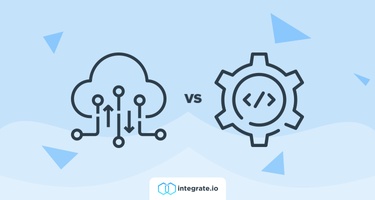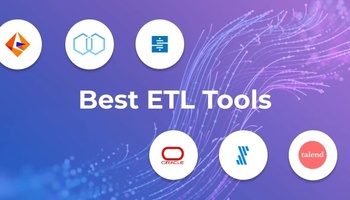Most organizations have more data on hand than they know what to do with—but collecting this information is only the first step. To make the most of your enterprise data, you need to migrate it from one or more sources, and then transfer it to a centralized data warehouse for efficient analysis and reporting.
You’ll often hear the terms “data ingestion” and “ETL” used interchangeably to refer to this process. However, although data ingestion and ETL are closely related concepts, they aren’t precisely the same thing. So what’s the difference between data ingestion and ETL, and how do the differences between ETL and data ingestion play out in practice?
What is Data Ingestion?
The term “data ingestion” refers to any process that transports data from one location to another so that it can be taken up for further processing or analysis. In particular, the use of the word “ingestion” suggests that some or all of the data is located outside your internal systems. The two main types of data ingestion are:
- Batch data ingestion, in which data is collected and transferred in batches at regular intervals.
- Streaming data ingestion, in which data is collected in real-time (or nearly) and loaded into the target location almost immediately.
Both batch and streaming data ingestion have their pros and cons. Streaming data ingestion is best when users need up-to-the-minute data and insights, while batch data ingestion is more efficient and practical when time isn’t of the essence.
Data ingestion is similar to, but distinct from, the concept of data integration, which seeks to integrate multiple data sources into a cohesive whole. With data integration, the sources may be entirely within your own systems; on the other hand, data ingestion suggests that at least part of the data is pulled from another location (e.g. a website, SaaS application, or external database).
What is ETL?
The term ETL (extract, transform, load) refers to a specific type of data ingestion or data integration that follows a defined three-step process:
- First, the data is extracted from a source or sources (e.g. files, databases, SaaS applications, or websites).
- Next, the data is transformed according to specific business rules, cleaning up the information and structuring it in a way that matches the schema of the target location.
- Finally, the data is loaded into the target location. This may be a data warehouse (a structured repository for use with business intelligence and analytics) or a data lake (a very large repository that can accommodate unstructured and raw data).
ETL is one type of data ingestion, but it’s not the only type. ELT (extract, load, transform) refers to a separate form of data ingestion in which data is first loaded into the target location before (possibly) being transformed. This alternate approach is often better suited for unstructured data and data lakes, where not all data may need to be (or can be) transformed.
Data Ingestion vs. ETL: What's the Difference?
As mentioned above, ETL is a special case of data ingestion that inserts a series of transformations in between the data being extracted from the source and loaded into the target location.
Just a few different types of ETL transformations are:
- Aggregation: Merging two or more database tables together.
- Cleansing: Removing information that is inaccurate, irrelevant, or incomplete.
- Deduplication: Deleting duplicate copies of information.
- Joining: Combining two or more database tables that share a matching column.
- Splitting: Dividing a single database table into two or more tables.
- Summarization: Creating new data by performing various calculations (e.g. summing up the revenue from each sales representative on a team).
- Validation: Ensuring that the data is accurate, high-quality, and using a standard format (e.g. converting all timestamps into Greenwich Mean Time).
Data ingestion acts as a backbone for ETL by efficiently handling large volumes of big data, but without transformations, it is often not sufficient in itself to meet the needs of a modern enterprise. Organizations cannot sustainably cleanse, merge, and validate data without establishing an automated ETL pipeline that transforms the data as necessary.
Some newer data warehouse solutions allow users to perform transformations on data when it’s already ingested and loaded into the data warehouse. So why then is ETL still necessary?
In fact, ETL, rather than data ingestion, remains the right choice for many use cases. For example, ETL is likely preferable to raw data ingestion if you’ll be querying the data over and over, in which case you’ll only need to transform the data once before loading it into the data warehouse. In-warehouse transformations, on the other hand, need to transform the data repeatedly for every ad hoc query that you run, which could significantly slow down your analytics runtimes.
Here at Integrate.io, many of our customers have a business intelligence dashboard built on top of a data warehouse that needs to be frequently updated with new transformations. Using Integrate.io to perform the transformation step dramatically speeds up the dashboard update process.
Data Ingestion vs. ETL Use Cases
ETL Use Cases
ETL has a wide variety of possible data-driven use cases in the modern enterprise. According to a study by McKinsey & Company, for example, businesses that intensively use customer analytics are 23 times more likely to succeed at customer acquisition, and 19 times more likely to be highly profitable.
One popular ETL use case: sales and marketing departments that need to find valuable insights about how to recruit and retain more customers. Because these teams have access to a great deal of data sources, from sales calls to social media, ETL is needed to filter and process this data before any analytics workloads can be run.
ETL is also widely used to migrate data from legacy systems to new IT infrastructure. ETL solutions can extract the data from a source legacy system, transform it as necessary to fit the new architecture, and then finally load it into the new system.
The transformation stage of ETL is especially important when combining data from multiple sources. Transformations such as data cleansing, deduplication, summarization, and validation ensure that your enterprise data is always as accurate and up-to-date as possible.
Data Ingestion Use Cases
Because big data is characterized by tremendous volume, velocity, and variety, the use cases of data ingestion (without transformation) are rarer. For example, data ingestion may be used for logging and monitoring, where the business needs to store raw text files containing information about your IT environment, without necessarily having to transform the data itself.
With a bit of adjustment, data ingestion can also be used for data replication purposes as well. Data replication is the act of storing the same information in multiple locations (e.g. different servers or nodes) in order to support the high availability of your data. In the event that one of the servers or nodes goes down, you can continue to access the replicated data in a different location.
There’s only a slight difference between data replication and data ingestion: data ingestion collects data from one or more sources (including possibly external sources), while data replication copies data from one location to another. Because data replication copies the data without transforming it, ETL is unnecessary here and we can simply use data ingestion instead.
Data Ingestion vs. ETL Priorities
For businesses that use data ingestion, their priorities generally focus on getting data from one place to another as quickly and efficiently as possible. On the other hand, because ETL incorporates a series of transformations by definition, ETL is better suited for situations where the data will necessarily be altered or restructured in some manner.
For example, ETL can be used to perform data masking: the obfuscation of sensitive information so that the database can be used for development and testing purposes. The names and Social Security numbers of individuals in a database might be scrambled with random letters and numerals while still preserving the same length of each string, so that any database testing procedures can work with realistic (yet inauthentic) data.
How Integrate.io Can Help
When it comes to the question of data ingestion vs. ETL, here’s what you need to know:
- Data ingestion refers to any importation of data from one location to another; ETL refers to a specific three-step process that includes the transformation of the data between extracting and loading it.
- Data ingestion focuses only on the migration of data itself, while ETL is also concerned with the transformations that the data will undergo. ETL is needed when the data will undergo some transformation prior to being stored in the data warehouse. For example, ETL is better suited for special use cases such as data masking and encryption that are designed to protect user privacy and security.
Looking for a powerful yet user-friendly data integration platform for all your ETL and data ingestion needs? Give Integrate.io a try. With our low-code, drag-and-drop interface and more than 100 pre-built connectors, we make it easier than ever to build data pipelines from your sources and SaaS applications to your choice of data warehouse or data lake. To get started, schedule a call with our team today for a chat about your business needs and objectives, or to begin your free trial of the Integrate.io platform.











